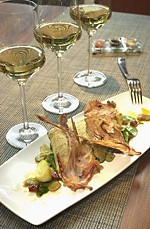Liquid Assets
Sparkling wines and champagnes
By Wes Marshall, Fri., Dec. 28, 2001
A little clarification is in order. First, all Champagnes are sparkling wines, but only a small percentage of sparkling wines are Champagne. The difference between the two is where they are born. Champagne is from a little corner of northeast France while sparklers are from the other side of the tracks, i.e., everywhere else. Second, almost all sparkling wines are bafflingly designated Brut (very dry) or Extra Dry (just slightly sweet). That is despite the fact that Dry means "not-sweet" everywhere else on Earth, so Extra Dry should mean "really not-sweet." It's a French thing. Finally, true Champagne can be made from only three grapes: chardonnay, pinot noir, and pinot meunier. Sparkling wines can be made from any grape you can imagine. I've tried some weird ones over the years, but most of the world still tries to emulate Champagne.
These wines come in a continuum of styles, from light with an apple-ish flavor to full-bodied with vanilla and toasty flavors. For the well-heeled and curious, one of the best ways to learn about the subtleties is to buy a bottle of light Champagne such as the ever-elegant Perrier-Jouët Grand Brut and a bottle of more intense stuff like Bollinger and then taste both and see which you like. This little exercise, though about $75 to implement, will serve you well for life because you will always be able to tell which end of the spectrum pleases you.
But don't wines taste different every year? Not in Champagne. They usually blend wines from different vintages to make sure that there is consistency in what they release year after year. A Mumm Cordon Rouge ($30) you drink this year should taste almost identical to the one your parents drank when you were born. So if you find something you like, unless your tastes change, you'll be able to stick with it forever. When I'm looking for Champagne, the occasion dictates the cost. The bottom end of the range is $30-plus. I buy Perrier-Jouët (light), Piper Heidsieck (medium), and Bollinger NV Brut (full). If my fictional rich uncle were buying, I'd plump for Dom Ruinart Rosé ($100). If your fictional rich uncle were buying, I'd go straight to Taittinger Comtes de Champagne Rosé ($250).
France doesn't have a monopoly on great sparkling wines. Especially over the past 10 years, several other areas have had quality surges. California has been able to come close to matching the quality of Champagnes and at very fair prices. Some of my favorites are Iron Horse Vineyards Brut Rosé ($33), Roederer Estate Brut ($22), and Pacific Echo Brut ($18). One of the world's great wine bargains comes from neighboring New Mexico where the Gruet family makes their world-class Blanc de Noirs ($14), a wine that will give you 80% of the Champagne experience at 30% of the price. It's the standard pour in our house.
Below is a list of what some of Austin's better stores consider to be their best value (not necessarily the cheapest) sparkling wines. Note that there are only two under $10, testament to the difficulty of making a good, cheap sparkling wine. There is one recommendation for a light style and one for a full style from each place.
The Austin Wine Merchant
Light: Contadi Castaldi Brut, $17
Full: Charles Heidsick 1990 Vintage Brut, $58.75
The Cellar
Light: Montaudon Millennium Brut, $42.50
Full: Bollinger Grande Annee, $85.00
Central Market North
Light: Jean-Milan Grand Cru Blanc de Blanc Sec "Tendresse", $38.99
Full: Contadi Castaldi Rosé Franciacorta, $32.99
Central Market South
Light: Taltarni Brut, $17.99
Full: Billecart-Salmon Cuvée Nicolas 1991, $90.00
Grape Vine Market
Light: L. Palais Blanc de Blanc, $8.99
Full: Bonnaire Brut Grand Cru, $29.49
Twin Liquors On Bee Caves Rd. in West Lake
Light: Oudinot Brut Premier Cru, $19.99
Full: Oudinot Rose, $22.99
Wiggy's
Light: Willm Brut Cremant, $8.99
Full: Chartogne-Taillet Fiacre, $41.99
Bottles From the Bible
We all know the standard Champagne bottle -- 750 milliliters in size, which grants us about five glasses. Next up is the magnum, 1.5 liters (two bottles) for about 10 glasses. Sometime in the mid- to late 1800s, the powers in Champagne decided to go to the Bible for naming the largest bottles of sparkly. A Jeroboam, named for one of the kings of Israel, is equal to four bottles, or 20 glasses. After that, we come to the Methuselah, named for the famous 969-year-old fellow, which is the same as eight normal bottles and yields 40 glasses. Salmanazar, the Assyrian king who ruled over Jerusalem, provides the name for a nine-liter bottle, equivalent to 12 bottles, which yields 60 glasses of wine for your friends' enjoyment. The Balthazar, commemorating one of the three wise men, is equal to 16 bottles or about 80 glasses of bubbly. The big boy is named for Balthazar's grandfather, Nebuchadnezzar, the king of Babylon, equal to 20 bottles or 100 glasses. Once we get into the Biblical names, these bottles are hand-blown and heavy. You might want to go down to World Gym and find some brutes to help you manage these big bottles. What's more, there's no quantity discount. The bigger they get, the more punishingly expensive they are.








